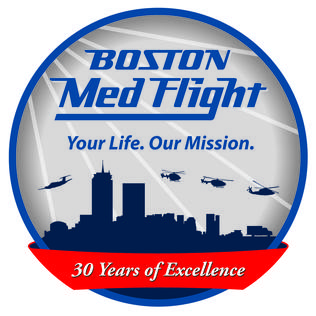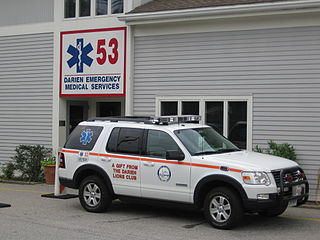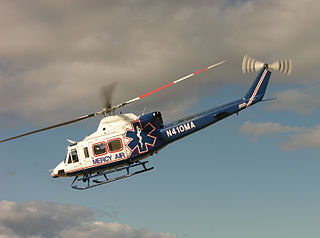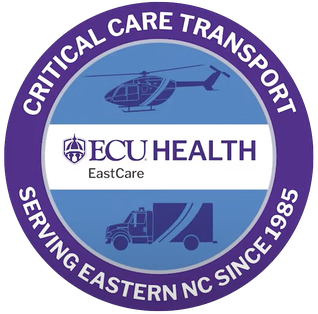Related Research Articles

Emergency medical services (EMS), also known as ambulance services or paramedic services, are emergency services that provide urgent pre-hospital treatment and stabilisation for serious illness and injuries and transport to definitive care. They may also be known as a first aid squad, FAST squad, emergency squad, ambulance squad, ambulance corps, life squad or by other initialisms such as EMAS or EMARS.

An emergency medical technician is a medical professional that provides emergency medical services. EMTs are most commonly found serving on ambulances and in fire departments in the US and Canada, as full-time and some part-time departments require their firefighters to be EMT certified.

A paramedic is a healthcare professional trained in the medical model, whose main role has historically been to respond to emergency calls for medical help outside of a hospital. Paramedics work as part of the emergency medical services (EMS), most often in ambulances. They also have roles in emergency medicine, primary care, transfer medicine and remote/offshore medicine. The scope of practice of a paramedic varies between countries, but generally includes autonomous decision making around the emergency care of patients.
ARCH Air Medical Service is an emergency medical service (EMS) that provides critical care air ambulance service in Missouri, Illinois, and the surrounding regions. Air ambulance programs offer transport by helicopter (rotor-wing) or fixed-wing aircraft. ARCH Air was the twelfth program in the U.S. to offer such services when it began operating in March 1979. Transporting approximately 4,200 patients per year by helicopter, ARCH aircraft are staffed by a pilot, nurse and paramedic. Flights are 80% inter-facility and 20% scene.

In the United States, the paramedic is a allied health professional whose primary focus is to provide advanced emergency medical care for patients who access Emergency Medical Services (EMS). This individual possesses the complex knowledge and skills necessary to provide patient care and transportation. Paramedics function as part of a comprehensive EMS response under physician medical direction. Paramedics often serve in a prehospital role, responding to Public safety answering point (9-1-1) calls in an ambulance. The paramedic serves as the initial entry point into the health care system. A standard requirement for state licensure involves successful completion of a nationally accredited Paramedic program at the certificate or associate degree level.

The Shock Trauma Air Rescue Service is a Canadian non-profit helicopter air ambulance organization funded by individual donors, service groups, corporate donors and government contributions. STARS provides rapid and specialized emergency care and transportation for critically ill and injured patients. STARS operates from bases in Calgary, Edmonton, Grande Prairie, Regina, Saskatoon, Winnipeg and formerly Halifax.

Boston MedFlight (BMF) is a non-profit organization that provides emergency scene response and emergency interfacility transfer in Eastern Massachusetts at the Critical Care level, which is higher than a paramedic-level ambulance crew's certification, using both aircraft and ground ambulances.

The Center for Emergency Medicine of Western Pennsylvania is a multi-hospital consortium based in Pittsburgh, Pennsylvania. It is claimed to be one of the world's premiere centers of Emergency Medicine and EMS development. It currently ranks sixth for residencies in emergency medicine by reputation.

STAT MedEvac is a service of the Center for Emergency Medicine of Western Pennsylvania in Pittsburgh, Pennsylvania. The primary function of STAT MedEvac is to provide emergency medevac and air medical transport of critically wounded or sick civilians, either from emergency scenes or between hospitals. As of July of 2017, the organization also operates two ground ambulances for patients with severe injury or critical illness. STAT MedEvac is directed by a consortium of hospitals of the University of Pittsburgh Medical Center (UPMC) that include UPMC Children's Hospital of Pittsburgh, UPMC Altoona, UPMC Hamot, UPMC Mercy and UPMC Presbyterian Shadyside. STAT MedEvac's base of operations is in West Mifflin, Pennsylvania, at the Allegheny County Airport. With 18 air bases across Pennsylvania, Maryland, New York, Ohio, and the District of Columbia, it is one of the largest single operated and dispatched air-medical service organizations in the United States.

In the United States, emergency medical services (EMS) provide out-of-hospital acute medical care and/or transport to definitive care for those in need. They are regulated at the most basic level by the National Highway Traffic Safety Administration, which sets the minimum standards that all states' EMS providers must meet, and regulated more strictly by individual state governments, which often require higher standards from the services they oversee.

Emergency medical services in Canada are the responsibility of each Canadian province or territory. The services, including both ambulance and paramedic services, may be provided directly by the province, contracted to a private provider, or delegated to local governments, which may in turn create service delivery arrangements with municipal departments, hospitals or private providers. The approach, and the standards, vary considerably between provinces and territories.

The safety of emergency medical services flights has become a topic of public interest in the United States, with the expansion of emergency medical services aviation operations, such as air ambulance and MEDEVAC, and the increasing frequency of related accidents.
Emergency medical services in Italy currently consist primarily of a combination of volunteer organizations providing ambulance service, supplemented by physicians and nurses who perform all advanced life support (ALS) procedures. The emergency telephone number for emergency medical service in Italy is 118. Since 2017 it has also been possible to call by the European emergency number 112, although this is a general police/fire/medical number.
Emergency medical services in the Netherlands is a system of pre hospital care provided by the government in partnership with private companies.
Air ambulances in the United States are operated by a variety of hospitals, local government agencies, and for-profit companies. Medical evacuations by air are also performed by the United States Armed Forces and United States National Guard.
Air Evac EMS, Inc., operating as Air Evac Lifeteam and sometimes called simply Air Evac, is an American helicopter emergency medical service (HEMS) or air ambulance provider headquartered in O'Fallon, Missouri. It is the largest subsidiary of Global Medical Response, though still considered an independent provider. It is also the largest membership-supported air ambulance service in the US operating helicopters from 140 bases in 15 states, mostly in the central and southern regions of the country. While primarily a HEMS provider, it also operates 2 fixed-wing aircraft in Missouri and Kentucky.

ECU Health EastCare is the critical care mobile air and ground transport of ECU Health at ECU Health Medical Center. It serves 31 counties in Eastern North Carolina. It is sponsored by ECU Health Medical Center and The Brody School of Medicine at East Carolina University. ECU Medical Center is the only level 1 trauma center east of Raleigh. EastCare's five full-time air ambulances constitute the largest air medical program in North Carolina and can serve a radius of 230 nautical miles around Greenville without refueling.

AirMed International, LLC, based in Birmingham, Alabama, is aa FAA-approved fee-for-service air ambulance airline. AirMed holds accreditation from the Commission on Accreditation of Medical Transport Systems (CAMTS) and the European Aero-medical Institute, and is an accredited service provider with the International Assistance Group (IAG).
åCALSTAR is a regional air medical services company serving California and northern Nevada. It operates as a nonprofit air ambulance provider on the West Coast.

Air medical services are the use of aircraft, including both fixed-wing aircraft and helicopters to provide various kinds of medical care, especially prehospital, emergency and critical care to patients during aeromedical evacuation and rescue operations.
References
- ↑ Accredited program list from the CAMTS website Archived May 29, 2011, at the Wayback Machine
- ↑ REMSA press release, August 14, 2002 Archived September 28, 2007, at the Wayback Machine
- ↑ CAMTS background information, CAMTS.org Archived 2007-07-02 at the Wayback Machine
- 1 2 Washington Proposed Rule WSR 00-17-181 Archived 2006-09-29 at the Wayback Machine
- ↑ Mediplane's CAMTS information page Archived 2007-08-18 at the Wayback Machine
- 1 2 Robert Davis, "Reconsidering air ambulance usage", USA Today, July 18, 2005, accessed July 13, 2007
- ↑ Colorado House Bill 07-1259 Archived 2013-07-30 at the Wayback Machine
- ↑ State of New Jersey Assembly Act No. 3786 Archived 2012-02-07 at the Wayback Machine
- ↑ "New Mexico Register, Volume XVI, Number 24, December 30, 2005". Archived from the original on July 30, 2013. Retrieved July 14, 2007.
- ↑ Utah Rule R426-2 Archived 2013-07-30 at the Wayback Machine
- ↑ Washington State rule WAC 246-976-320 [ permanent dead link ]
- ↑ "RULES AND REGULATIONS RELATING TO EMERGENCY MEDICAL SERVICES" (PDF). STATE OF RHODE ISLAND AND PROVIDENCE PLANTATIONS DEPARTMENT OF HEALTH. April 2014. Retrieved 4 November 2017.
- ↑ "Draft of proposed changes to Texas Department of State Health Services rule 157.12, January 25, 2006" (PDF). Archived from the original (PDF) on November 21, 2007. Retrieved July 14, 2007.
- ↑ "Texas DSHS committee minutes" (PDF). Archived from the original (PDF) on 2007-11-21. Retrieved 2007-07-14.
- ↑ "Air Evac Lifeteam | Air Medical Ambulance Service". Air Evac Lifeteam. Retrieved 2017-11-04.
- 1 2 "ACCREDITED SERVICES – CAMTS". www.camts.org. Retrieved 2018-08-12.
- ↑ "International". Archived from the original on 2016-04-27. Retrieved 2016-04-03.